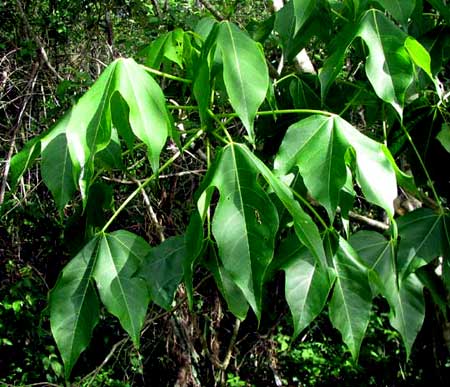
In the late dry season, around early March, you might be lucky enough to see the thick-stemmed, dry-season-leafless, smallish tree about 15 feet tall (4.5m) in full flower as shown below:

When I first saw this tree I couldn't imagine what it was. I knocked down a few flowers and their structure was unlike anything I'd ever seen. All I could do was wait for fruits in the hope that they would look like something familiar. When they appeared, however, I was even more amazed. That's them below:

Those leaves in the picture developing at branch tips looked rather familiar, like the Chaya I eat each day, but I'd never seen such one-seeded, samara-type fruit bearing two rabbit-ear wings. Even with this extra information and long hours on the Internet I couldn't figure them out.
Eventually the fruits fell and I got to see them up close, and the leaves expanded, revealing that they were "palmately lobed" -- with segments like thick fingers radiating from the palm of a hand -- as shown below:

Now I could figure it out, and what I discovered was wonderful.
The trees belong to a family I'd never seen before, the Hernandia Family, the Hernandiaceae. On the Phylogenetic Tree of Life the Hernandicaceae usually is placed near the Laurel Family. The tree itself is Gyrocarpus jatrophifolius, and the only English name I can find for it is Helicopter Tree, referring to the way its fruits spin as they fall. My Maya friends have nothing to say about it.
Helicopter Trees are spottily distributed throughout much of southern Mexico and Central America, but apparently nowhere are they common. Little is known about them, and I regard them as one of the most interesting, obscure woody plants I've ever met.